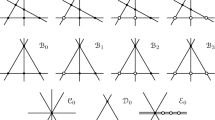Abstract
In classical projective geometry, a double six of lines consists of 12 lines ℓ 1, ℓ 2, . . . , ℓ 6, m 1, m 2, . . . , m 6 such that the ℓ i are pairwise skew, the m i are pairwise skew, and ℓ i meets m j if and only if i ≠ j. In the 1960s Hirschfeld studied this configuration in finite projective spaces PG(3, q) showing they exist for almost all values of q, with a couple of exceptions when q is too small. We will be considering double-k sets in the symplectic geometry W(q), which is constructed from PG(3, q) using an alternating bilinear form. This geometry is an example of a generalized quadrangle, which means it has the nice property that if we take any line ℓ and any point P not on ℓ, then there is exactly one line through P meeting ℓ. We will discuss all of this in detail, including all of the basic definitions needed to understand the problem, and give a result classifying which values of k and q allow us to construct a double k-set of lines in W(q).
Similar content being viewed by others
References
Hirschfeld J.W.P.: The double-six of lines over PG(3, 4). J. Austral. Math. Soc. 4, 83–89 (1964)
Hirschfeld J.W.P.: Classical configurations over finite fields: I. The double-six and the cubic surface with 27 lines. Rend. Mat. e Appl. 26, 115–152 (1967)
Hirschfeld J.W.P.: Classical configurations over finite fields: II. Grace’s extension of the double-six. Rend. Mat. e Appl. 26, 349–374 (1967)
Hirschfeld J.W.P.: A projective configuration. In: Computational Problems in Abstract Algebra, pp. 321–323. Pergamon, Oxford (1970).
Payne S.E.: Tight sets in finite generalized quadrangles. Cong. Num. 60, 243–260 (1987)
Payne S.E., Thas J.A.: Finite Generalized Quadrangles, 2nd edn. European Mathematical Society, Zurich (2009)
Author information
Authors and Affiliations
Corresponding author
Additional information
Communicated by J. W. P. Hirschfeld.
Rights and permissions
About this article
Cite this article
Payne, S., Rodgers, M. Double k-sets in symplectic generalized quadrangles. Des. Codes Cryptogr. 72, 265–271 (2014). https://doi.org/10.1007/s10623-012-9761-8
Received:
Accepted:
Published:
Issue Date:
DOI: https://doi.org/10.1007/s10623-012-9761-8



